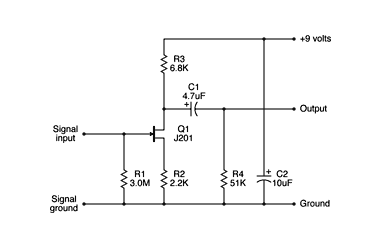The principle of a bootstrapped device is actually quite simple to understand.
Cornish buffers are emitter followers, meaning they have a voltage gain close to one. On emitter followers, the signal is taken from the emitter and it is nearly a 1:1 copy of the input. A suitably large capacitor will convey any voltage change on the emitter back to the base, which is why both of them "see" the same voltage. No voltage change means no current change. No current change means infinite resistance.
Note: this is only valid
for a signal change, not for static conditions.
What "AC" means in this therm is determined by the size of the bootstrapping capacitor obviously.
Cornish describes a scenario in his
case against true bypass that probably will not affect 95% of us guys here.
That said, I am a long time promoter of buffering, but where necessary (and it is necessary in the scenario Cornish describes).
It is true that very many pedals have a too low impedance. Fuzz faces and derivatives are notorious for that, and should and
can be fixed.
The purported "sterile tone" is just lack of understanding of the problem.
On the above linked page he writes:
a fiendishly clever pre amp that has the same characteristics as the input of a tube amp (1 Megohm/20pF), a highly efficient filter to eliminate the possibility of radio breakthrough and a low output impedance so that any following pedals/ cables etc. will not impose a load on the guitar signal.
Excuse me, but this is applied a bit thickly for my taste, to put it mildly (probably to highlight its superiority)
Provided he talks about the same circuit as we here,
- I do not see what is so extraordinary about it, although its components are certainly chosen with care for low noise and max. headroom.
- 1 Mohm is nothing extraordinary. 20pF is not needed, any length of cable will soon have several hundreds of pF.
- The highly efficient RF filter is a mere capacitor chosen big enough to roll off all RF frequencies (note that the small cap on the base will cancel out too...)
- Low output impedance... any old follower can do that. A few 100 Ohms are plenty low enough.
Although I believe the problem must be paid attention to, two such buffers stacked are way overkill.
The principle is proven working, which is why he uses it.
OP-amps principally work, but with today's flood of OPA's and their touted all-around superiority (and probably programmed obsolescence)
you have no time to gain experience on their overload recovery behavior, their headroom, their clipping mechanism and so on. We do not know how well the input is protected against spikes.
Note that the op-amp follower shown here somewhere
will not work in the bare-bone configuration shown. It needs a bias, it has no RF protection etc. Very many schematics available do not provide any such protection.
With all this ado about keeping the signal pristine, one problem I never saw mentioned in this context is that
the signal degrades, as soon as it leaves the guitar. Although a bit cumbersome in practise, the signal should be buffered
right at the guitar, or tone will be degraded by the time it hits the first input. And this applies regardless of the subsequent device, even if it were a tube amp grid. The cable capacity has done its job.
Edit: The "C"-Buffer or the "K"-Buffer are highly regarded. They sound so good. This is entirely ridiculous. You will never
hear any buffer. What you hear is the absence of the gremlins it just saved you from. Somebody even sells a K/C buffer.

Note that the cherished K-Buffer
does not have any RF protection.
While the point Cornish brings up might be debatable, the double buffering appears a total overkill to me. What is not debatable is that many circuits and maybe a Muff too have a too low input impedance and
do benefit from a buffered front-end, true bypass or not.
Hope this helps.

